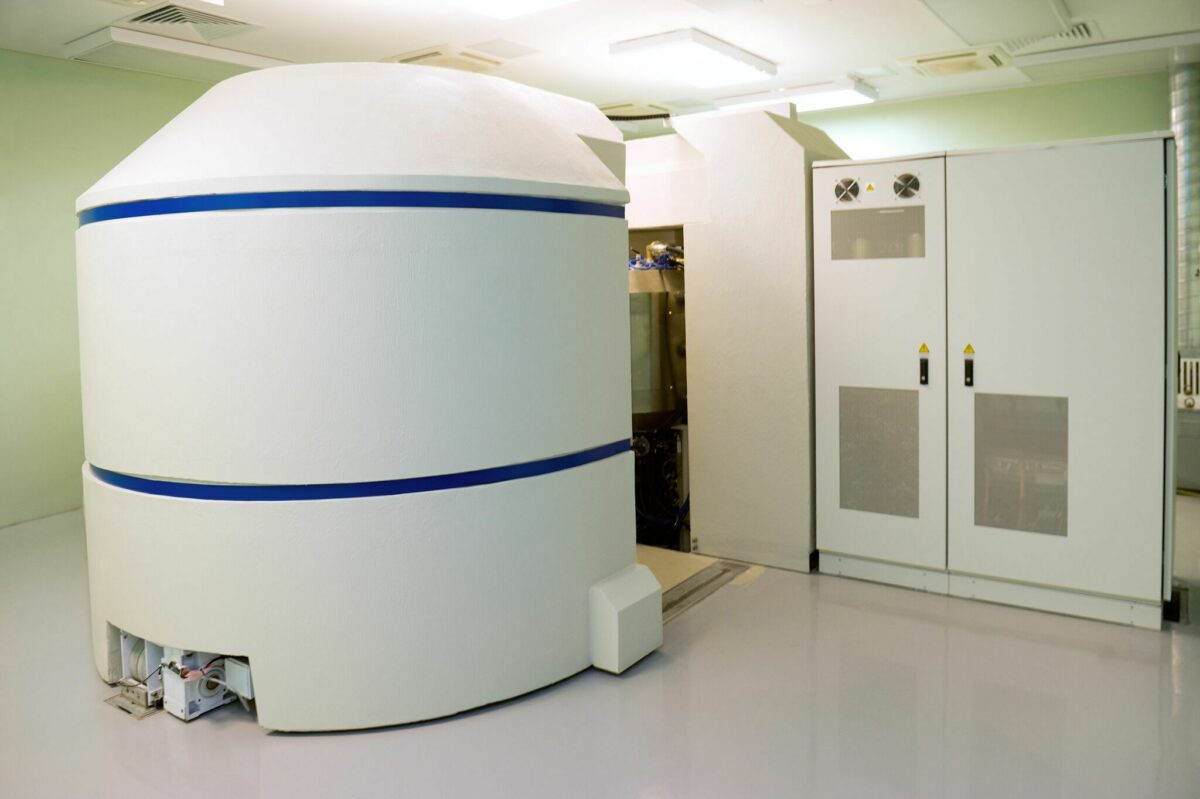
Introduction
Particle accelerators, such as linear accelerator (LINAC) and cyclotron systems, increase the kinetic energy of particles for use in a variety of applications, ranging from scientific studies on particle physics to radiation therapy for cancer patients. Particle accelerators, like most sensitive medical and laboratory equipment, are negatively affected by thermal variations, specifically an increase in heat.
Temperature control of vital particle accelerator system components is critical for operational integrity, performance accuracy and system reliability. The increasing intricacy of thermal management means that particle accelerator systems often require custom liquid cooling systems. However, these more advanced liquid cooling systems don’t have to extend the design cycle, or the budget.
LINAC Background
LINACs are types of particle accelerators that increase the kinetic energy of particles for use in a variety of applications, ranging from scientific studies on particle physics to radiation therapy for cancer patients. For example, intensity-modulated radiation therapy (IMRT) uses a miniature linear particle accelerator to target tumor cells. While all body cells can be damaged by radiation, tumor cells are even more susceptible to it. Radiation therapy is used to specifically target the tumor while sparing nearby normal tissue.
A LINAC is used to produce and deliver the radiation beam to the targeted area through a complex system. Electrons are injected into the waveguide, where the number of electrons is controlled by the temperature of the filament material. A vacuum is created for the waveguide to ensure that the electron beam is not impeded by other particles. Electric fields accelerate the electrons and increase the kinetic energy of the beam. A series of magnets controls the path of electrons through the flight tube, focusing the beam. X-rays are produced as the high-energy electron beam hits a heavy metal target material. Filters, dosimeters and collimators are used to minimize leakage, measure the radiation dose, and direct and shape the X-ray beam so that, on exit from the gantry, its shape matches the shape of the tumor.

Cyclotron Background
Two additional imaging techniques for cancer patients using particle accelerator systems are positron emission tomography (PET) and single-photon emission computed tomography (SPECT). These systems use a specific particle accelerator, known as a cyclotron, to create a radio tracer made from glucose, which is drawn to tumors. After this substance is ingested, inhaled or injected into the patient, it concentrates in the tumors within the body, allowing the PET or SPECT system to image the tumor by detecting the gamma rays coming from the patient.
The cyclotron creates the radioactive isotopes by accelerating a fluid or gas in an outward spiral path and bombarding it with neutrons to create charged particles. The spiral path is maintained by a magnetic field, and the particles are accelerated by an applied electric field. The advantage a cyclotron is the maximum achievable extracted proton current, which is currently 2.2 mA. The energy and current correspond to 1.3 MW beam power, which is the highest of any accelerator currently existing. The radioactive substance produced for a PET scan has a very short half-life (i.e., a rapid decay time). A SPECT uses a different radioactive substance with a longer half-life and is used for other types of imaging. Because of the half-life of the radioactive material, the cyclotron needs to be installed near the PET or SPECT system, so it can be generated and given to the patient just before the imaging is done.
Cooling Systems Requirements
Within the LINAC used in IMRT equipment, thermal consistency is required to maintain beam energy and stability. The tungsten target, the waveguide, the acceleration chamber and the magnets all require precise thermal management to dissipate heat buildup and maintain temperature stability for optimal operation.
Certain components in an IMRT system, like the wave guide and filament material, need thermal control within about 0.5°C, thus a liquid cooling system is most likely the best option. Components in the electronic cabinet, like amplifiers and power supplies, may also require cooling from a liquid cooling system if cold plates or heat exchangers cannot offer sufficient or efficient cooling performance. In a standard IMRT system, the cooling path is typically complicated. The facility water cools the charge drawer and oil pump, and then feeds to a liquid cooling system, which basically cools the rest of the system including the linear accelerator.

Cyclotron systems require cooling of the components that generate the radioactive substance, including the magnets, ion sources, cryopump, and the water circuitry. In addition, the amplifiers, power supplies, and vacuum chamber also need cooling. Cold plates and heat exchangers are typically used to cool amplifiers, power supplies and the vacuum chamber in a cyclotron system. A liquid cooling system is vital to cooling tubing connections, solenoid valves, beam stops, and electrically isolated collimators.
Types of Liquid Cooling Systems
Liquid cooling systems, which are self-contained units that recirculate coolant to a predefined set-point temperature, allow for optimal temperature stabilization for more precise temperature control. Liquid cooling systems are able to dissipate the large amount of heat generated in the densely packed electronic environment of linear accelerators and cyclotron systems. The introduction of a liquid coolant into a system of electronics need not be an item of concern as long as the liquid cooling system is designed and assembled properly. Liquid cooling systems offer higher efficiency than air-based heat exchangers, and provide more rapid cooling, quieter operation, higher reliability and more system uptime.
One type of liquid cooling system uses a liquid-air heat transfer configuration, whereby a high-pressure pump recirculates the liquid coolant and an air heat exchanger removes the heat from the liquid circuit, dissipating it to the ambient environment by means of a fan. The coolant can be water, a water-glycol mixture, or transformer oil, depending on the temperature at the heat source; an oil-cooled system is used when the temperature exceeds the operational temperature limit of the water-based systems.
A second type of liquid cooling system uses a liquid-liquid configuration, whereby the pump recirculates the coolant and ambient-temperature facility water is used in a liquid heat exchanger to dissipate heat on the hot side. The liquid-liquid system increases cooling capacity compared with the liquid-air system. These systems can be designed to operate with either water or oil as the coolant liquid, depending on the temperature environment.
A third type of liquid cooling system is a compressor-based chiller system, whereby the pump recirculates coolant that is chilled to well below ambient temperature. Heat from the coolant is absorbed by the compressor-based system and is dissipated to the outside environment.
The increasing complexity of thermal management means that IMRT and cyclotron system manufacturers often rely on external companies for temperature control solutions. Manufacturers like Laird Thermal Systems’ offer a series of standard and custom liquid cooling systems that provide liquid-to-air, liquid-to-liquid, or chiller-based systems in various sizes and cooling capacities. Its experience in the design, manufacture and servicing of liquid cooling systems, as well as expertise in pumps, compressor technology, evaporators and heat exchangers, allows IMRT and cyclotron manufacturers to focus on end product designs, while leaving the thermal management issues to the experts.
For all types of liquid cooling systems, additional features can add precise temperature control, variable coolant flow rate, coolants with corrosion inhibitors and coolant filtration, as needed. Temperature control of multiple liquid circuits is often required, as is high operational temperature. Control of multiple pressure drop settings to accommodate both low and high-pressure conditions may be needed.
Given the intricacy of some IMRT linear accelerator and cyclotron systems, usage of a custom designed liquid cooling system with plug-and-play components may be a good solution. For example, quick connect fittings to allow easy service and maintenance, such as a bottom drain for removing the coolant by gravity, or a pump that is easy to swap out if necessary, add to the system’s ease-of-use. Custom housing configurations for unique environments may be required. Laird Thermal Systems has the knowledge to custom design liquid cooling systems for these specific applications, as well as the experience to support and service them.
Looking Ahead
Depending on the particular IMRT system, stationary cooling systems can be used, while other IMRT systems place the cooling system on the moveable gantry. One advancement in IMRT technology is the movement from analog to digital processing in order to image the tumor and treat the patient at the same time, thereby presenting additional cooling complexities.
Cyclotron systems require a significant amount of cooling. Manufacturers are looking to reduce the size of cyclotrons and the cooling system so that the unit occupies a smaller footprint and a lesser amount of valuable floor space, which presents further cooling challenges due to the increase in the density of the electronics. As a result, many thermal management experts are looking to utilize a combination of liquid cooling systems and/or thermoelectric cooler assemblies, to cool cyclotron systems and in particular the detector arrays.
Conclusion
In today’s complex operating environment, liquid cooling systems are required to dissipate a large amount of heat in a densely packed electronic environment. Maximum operational life is required to keep particle accelerator system maintenance and repair down time to a minimum. Temperature stabilization has especially become critical, as next generation LINAC and cyclotron systems require more precise temperature control.
Source: Cooling Particle Accelerators: Linear Accelerators and Cyclotrons





